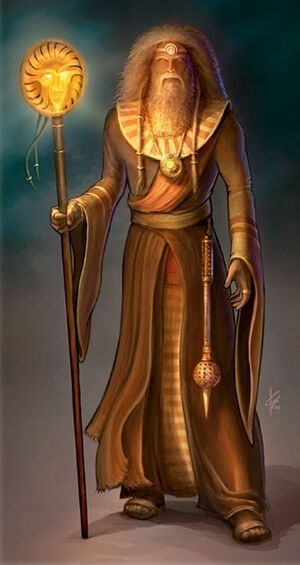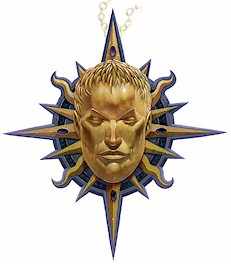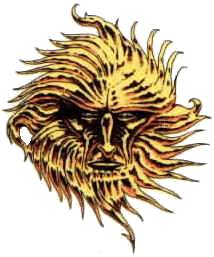Pelor: Difference between revisions
1d4chan>Biggus Berrus |
1d4chan>Dzeus m (typo) |
||
| Line 18: | Line 18: | ||
==Servants== | ==Servants== | ||
Many of Pelor's worshippers are humans, and most of them are the common | Many of Pelor's worshippers are humans, and most of them are the common folk that work the lands. He is not picky though, and all those willing to embrace his message. Pelor is a bit of a go-between god in this regard, not a crusader, not a deity of nature, or a god of magic. Because of this he is often worshipped alongside deities with a similar portfolio, but rarely an evil-aligned one. | ||
==Pelor, the Burning Hate== | ==Pelor, the Burning Hate== | ||
Revision as of 04:33, 9 July 2015

Pelor is the Good D&D deity of the sun, summer, agriculture and time.
The Dawn War
Pelor is one of the deities that fought in the Dawn War, the massive conflict between gods and primordials at the beginning of creation. He was at the forefront of many battles: both against primordials and fallen deites, like Tharizdun.
Along with Ioun and likely the then-not evil Tharizdun, he discovered the Living Gate. One of them dared to peer beyond the gate, and saw the madness beyond, which might have been the start of his madness.
Domain
Pelor is an archetypical Good Guy God. His domains contain the protection of the common man: ensure good harvests, the rising of the sun and opposes the marauding bands of Orcs that rampage by now and then. He is commonly worshipped by Humans, having at least one shrine near almost every Human settlement, regardless of size.
Dwelling
Pelor resides in Hestavar, a central hub in the Astral Sea and a beacon of light and civilisation. Here he has his own palace, Aurosion. He shares the city with two other deities, Erathis and Ioun. The latter has little interest in the day to day life in the city, so Pelor and Erathis have joint stewardship over the Bright City.
Though it is only implied, he and Erathis may or may not have something going on between them. What is sure is that though he approves of Erathis' mission, Pelor knows that there might be a point at which he has to restrain, stave off or outright stop the works or consequences of his Neutral fellow god.
Pelor himself has a proverbial skeleton in his closet too: several large fragments of the Living Gate, hidden in the deepest parts of his palace. Only a few, and certainly no Shardminds, know this, and the Shardminds of Hestavar are encouraged to try and build a new Living Gate.
Servants
Many of Pelor's worshippers are humans, and most of them are the common folk that work the lands. He is not picky though, and all those willing to embrace his message. Pelor is a bit of a go-between god in this regard, not a crusader, not a deity of nature, or a god of magic. Because of this he is often worshipped alongside deities with a similar portfolio, but rarely an evil-aligned one.
Pelor, the Burning Hate


There is another theory going around about the popularity of Pelor amongst humans. A long time ago there was a deity named Zarus. He was the god of Humanity, in the same way that Moradin is the god of the Dwarves. Zarus differed from the other gods-of-PC-races in that he wasn't Good, or even Neutral. He was a Lawful Evil deity who taught that humans were superior to all other species that lived on the world, and only by subjugation to humanity should they be allowed a continued existence.
Why Zarus disappeared is lost in time. What is not lost though is that in 3.5e, there were a number of cases of Pelor's followers using evil-aligned divine power (which should be impossible, since divine power from a good deity cannot generate power for evil spells), and many of Pelor's artifacts employ large-scale destruction, instead of the expected helping of the weak.
This is pure speculation though, and there is no conclusive evidence. But still, one should be careful when dealing with the guardian of time.
| The Deities of Dungeons & Dragons 4th Edition | |||
|---|---|---|---|
| Lawful | Neutral | Chaotic | |
| Good | Bahamut • Haramathur • Moradin | Amoth • Lakal • Nusemnee • Pelor | Avandra • Corellon • Sehanine |
| Neutral | Erathis • Raven Queen • Sagawehn | Aurom • Io • Ioun • Melora | Gorellik • Kord • Laeris |
| Evil | Asmodeus • Bane • Tiamat | Nerull • Torog • Vecna | Gruumsh • Khala • Lolth • Tharizdun • Zehir |